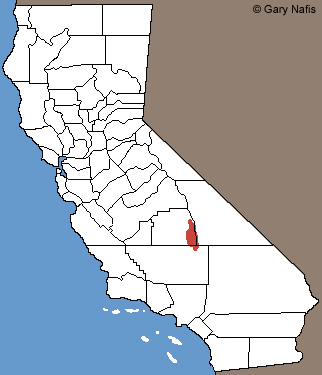 Red:
Red: Range in California
|
 |
| Adult, Tulare County |
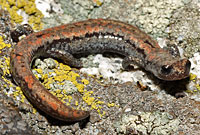 |
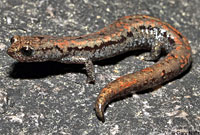 |
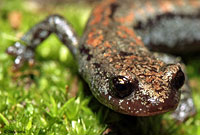 |
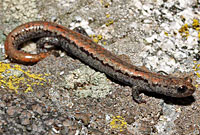 |
| |
Adult, Tulare County |
|
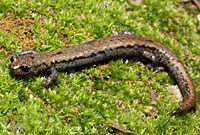 |
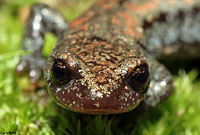 |
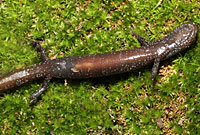 |
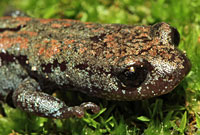 |
| |
Adult, Tulare County |
|
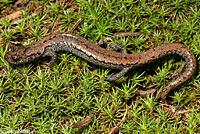 |
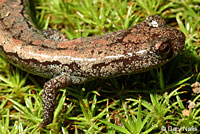 |
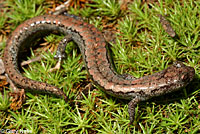 |
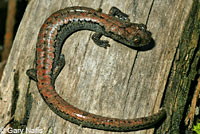 |
| |
Adult, Tulare County |
|
|
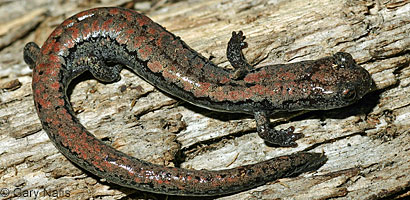 |
 |
| Adult, Tulare County |
Adult, Tulare County |
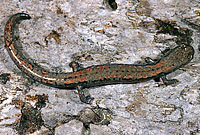 |
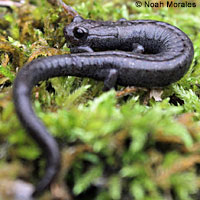 |
 |
| Adult, Tulare County |
Adult from the eastern slope of the Sierra Nevada Mountains in Inyo County.
© Noah Morales |
Adult from the eastern slope of the Sierra Nevada Mountains in Inyo County.
© Noah Morales |
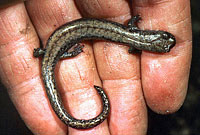 |
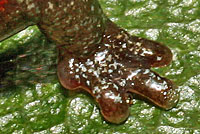 |
|
|
| Adult, Tulare County |
Slender Salamanders (genus Batrachoseps) have only 4 toes on their hind feet. All other California salamanders have 5 toes on their hind feet. |
|
|
| |
|
|
|
| Habitat |
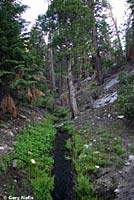 |
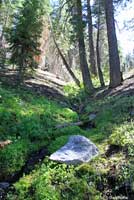 |
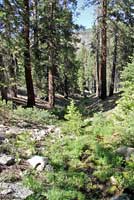 |
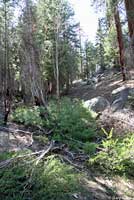 |
Habitat, small creek in forest,
7,200 ft., Tulare County |
Habitat, Tulare County |
Habitat, Tulare County |
Habitat, Tulare County |
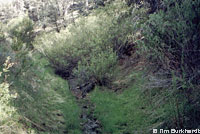 |
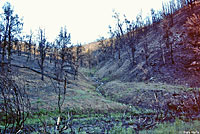 |
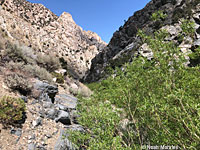 |
|
| Habitat before burn, small stream, 6,500 ft., Tulare County © Tim Burkhardt |
Same 6,500 ft. Tulare County habitat after burn, with salamanders still persisting along the edge of the stream. |
Habitat on the eastern slope of the Sierra Nevada Mountains in Inyo County.
© Noah Morales |
|
| |
|
|
|
| Short Video |
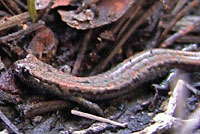 |
|
|
|
| Kern Plateau Slender Salamanders beside a small seep in the Sierra Nevada Mountains. |
|
|
|
|
|
|
|
| Description |
| |
| Size |
Adults are 1 3/4 - 2 1/4 inches long (4.4 - 5.7 cm) from snout to vent.
|
| Appearance |
A small slim salamander with 16 - 17 costal grooves.
Short limbs, a long slender body with a narrow head and a long tail, and conspicuous costal and caudal grooves give this species the worm-like appearance typical of most Slender Salamanders.
Relatively large and robust when compared with most Slender Salamanders, having a fairly broad head, long legs, broad feet, short tail, and large toes.
There are four toes on the front and hind feet, which is also typical of Slender Salamanders.
(Other California salamanders have five toes on the hind feet.) |
| Color and Pattern |
Color is rusty, bronze, gray, reddish, usually with a dorsal stripe and scattered flecks and spots.
The venter is gray or black in color.
The throat has heavy white mottling.
Animals from dryer habitats have lighter coloring of gray or silver, while those from coniferous forest tend to match the darker environment with red and brown coloring.
|
| Life History and Behavior |
A member of family Plethodontidae, the Plethodontid or Lungless Salamanders.
Plethodontid salamanders do not breathe through lungs. They conduct respiration through their skin and the tissues lining their mouth. This requires them to live in damp environments on land and to move about on the ground only during times of high humidity. (Plethodontid salamanders native to California do not inhabit streams or bodies of water but they are capable of surviving for a short time if they fall into water.)
Plethodontid salamanders are also distinguished by their nasolabial grooves, which are vertical slits between the nostrils and upper lip that are lined with glands associated with chemoreception.
All Plethodontid Salamanders native to California lay eggs in moist places on land.
The young develop in the egg and hatch directly into a tiny terrestrial salamander with the same body form as an adult.
(They do not hatch in the water and begin their lives as tiny swimming larvae breathing through gills like some other types of salamanders.)
|
| Activity |
Little is known about this species.
Most Slender Salamander species are active on rainy or wet nights when temperatures are moderate, fall through spring, retreating underground when the soil dries or when air temperature drops to near freezing.
At higher elevations, activity may be restricted to spring and early summer and early fall. In areas with perennial surface moisture, activity may continue through the summer. |
| Defense |
Slender salamanders use several defense tactics, including:
- Coiling and remaining still, relying on cryptic coloring to avoid detection.
- Uncoiling quickly and springing away repeatedly bouncing over the ground, then remaining still again to avoid detection.
- Detaching the tail, which wriggles on the ground to distract a predator from the salamander long enough for it to escape.
(After its tail is detached or severed, the salamander will grow a new tail.) |
| Diet and Feeding |
Most likely eats a variety of small invertebrates.
Feeding behavior is not well known, but other Batrachoseps species are sit-and-wait predators that use a projectile tongue to catch prey. |
| Reproduction |
Little is known about the breeding behavior of this species.
Reproduction is terrestrial.
Breeding and egg-laying probably occurs in spring after snow-melt. |
| Eggs |
All species of Slender Salamanders lay eggs, typically in moist places on land.
Gravid females have been found in early May.
Females in a lab laid three eggs.
Eggs in the lab hatched in 96 - 103 days. |
| Young |
Young develop completely in the egg and hatch fully formed.
Hatchlings were black with gold or silver flecking measuring about a half inch in length from snout to vent (12 - 13 mm).
|
| Habitat |
Found in moist habitats of pine and fir forests, and piñon pine, sagebrush, and oaks in drier habitats.
Found under logs, bark, rocks, and other debris especially near springs, seeps and outflow streams.
|
| Geographical and Elevational Range |
Endemic to California.
Occurs on the Kern Plateau of the southeastern Sierra Nevada in Kern County from 5,580 - 9,200 ft. (1,700 - 2,800 m), on the eastern slopes of the Sierra Nevada draining into the Owens Valley and Indian Wells Valley in Inyo County, at elevations of 4,690 to 8,000 ft. (1,430–2,440 m) and the Scodie Mountains in Kern County at elevations of 6,500 - 6,640 ft. (1,980 - 2,025 m).
|
| Notes on Taxonomy |
B. robustus was officially described in 2002. Specimens were first collected in 1972, but were misidentified as B. stebbensi.
DNA studies show that the more "robust" forms of Batrachoseps, B. robustus, B wrighti - Oregon Slender Salamander, and B. stebbinsi - Tehachapi Slender Salamander, are phylogenetically distant from other Batrachoseps species.
Here's a Diagram of the Batrachoseps Complex showing the relationships between species.
Names History
Batrachoseps robustus - Kern Plateau Slender Salamander (Wake, Yanev, Hansen 2003, Stebbins 2003, 2012)
|
| Conservation Issues (Conservation Status) |
| Listed as imperiled and near threatened. This is probably because its limited forested high-altitude riparian habitat makes it vulnerable to any alteration of the habitat. The populations in the Scodie mountains are small and isolated which makes them more vulnerable to habitat alteration. |
|
| Taxonomy |
| Family |
Plethodontidae |
Lungless Salamanders |
Gray, 1850 |
| Genus |
Batrachoseps |
Slender Salamanders |
Bonaparte, 1841 |
| Subgenus |
Plethopsis |
Slender Salamanders |
Bishop, 1937 |
Species
|
robustus |
Kern Plateau Slender Salamander |
Wake, Yanev, and Hansen, 2002 |
|
Original description |
Wake, D.B., K.P. Yanev, and R.W. Hansen. - 1/13/2003. "New species of slender salamander, Genus Batrachoseps, from the southern Sierra Nevada of California." 2002 Copeia 4:1016-1028.
|
|
Meaning of the Scientific Name |
Batrachoseps - Greek - batrachos = amphibian, frog + seps = lizard — describes lizard-like appearance
robustus - Latin = large bodied [refers to the body size compared to the thinner Batrachoseps species]
from Scientific and Common Names of the Reptiles and Amphibians of North America - Explained © Ellin Beltz
|
|
Alternate Names |
None
|
|
Similar Neighboring Salamanders |
Batrachoseps simatus
Batrachoseps relictus
Batrachoseps stebbinsi
Batrachoseps campi
Batrachoseps gregarious
Batrachoseps bramei
|
|
More Information and References |
California Department of Fish and Wildlife
AmphibiaWebSalamander Diversity in the Kern Valley Region
Resources List
Wake, D.B., K.P. Yanev, and R.W. Hansen. - 1/13/2003. "New species of slender salamander, Genus Batrachoseps, from the southern Sierra Nevada of California." 2002 Copeia 4:1016-1028.
Hansen, Robert W. and Shedd, Jackson D. California Amphibians and Reptiles. (Princeton Field Guides.) Princeton University Press, 2025.
Stebbins, Robert C., and McGinnis, Samuel M. Field Guide to Amphibians and Reptiles of California: Revised Edition (California Natural History Guides) University of California Press, 2012.
Stebbins, Robert C. California Amphibians and Reptiles. The University of California Press, 1972.
Flaxington, William C. Amphibians and Reptiles of California: Field Observations, Distribution, and Natural History. Fieldnotes Press, Anaheim, California, 2021.
Nicholson, K. E. (ed.). 2025. Scientific and Standard English Names of Amphibians and Reptiles of North America North of Mexico, with Comments Regarding Confidence in Our Understanding. Ninth Edition. Society for the Study of Amphibians and Reptiles. [SSAR] 87pp.
Stebbins, Robert C. A Field Guide to Western Reptiles and Amphibians, 3rd Edition. Houghton Mifflin, 2003
|
|
|
The following conservation status listings for this animal are taken from the July 2025 State of California Special Animals List and the July 2025 Federally Listed Endangered and Threatened Animals of California list (unless indicated otherwise below.) Both lists are produced by multiple agencies every year, and sometimes more than once per year, so the conservation status listing information found below might not be from the most recent lists, but they don't change a great deal from year to year.. To make sure you are seeing the most recent listings, go to this California Department of Fish and Wildlife web page where you can search for and download both lists:
https://www.wildlife.ca.gov/Data/CNDDB/Plants-and-Animals.
A detailed explanation of the meaning of the status listing symbols can be found at the beginning of the two lists. For quick reference, I have included them on my Special Status Information page.
If no status is listed here, the animal is not included on either list. This most likely indicates that there are no serious conservation concerns for the animal. To find out more about an animal's status you can also go to the NatureServe and IUCN websites to check their rankings.
Check the current California Department of Fish and Wildlife sport fishing regulations to find out if this animal can be legally pursued and handled or collected with possession of a current fishing license. You can also look at the summary of the sport fishing regulations as they apply only to reptiles and amphibians that has been made for this website.
|
| Organization |
Status Listing |
Notes |
| NatureServe Global Ranking |
G3 |
Vulnerable
|
| NatureServe State Ranking |
S3 |
Vulnerable |
| U.S. Endangered Species Act (ESA) |
None |
|
| California Endangered Species Act (CESA) |
None |
|
| California Department of Fish and Wildlife |
None |
|
| Bureau of Land Management |
None |
|
| USDA Forest Service |
None |
|
| IUCN |
NT |
Near Threatened |
|
|
|






























